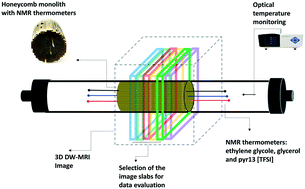Diffusion weighted magnetic resonance imaging for temperature measurements in catalyst supports with an axial gas flow†
Abstract
In situ thermometry of catalytic gas phase reactions allows the determination of temperature profiles in catalyst beds. In NMR imaging systems used for measuring the chemical composition of species in model reactors, temperature measurements by NMR spectroscopy are technically challenging and confined to a rather low temperature range. In this study, an optimized NMR in situ technique is proposed, which will allow the determination of the temperature distribution in highly exothermic reactions on structured catalysts. Diffusion weighted magnetic resonance imaging (DW-MRI) was successfully applied as an alternative method for temperature measurements commonly performed by chemical shift measurements using ethylene glycol. DW-MRI applied with different diffusion sensitizing gradients allows high-resolution imaging of the temperature dependent diffusion coefficient, without the need for high spatial homogeneity of the magnetic field. Using 3D DW-MRI on ethylene glycol, glycerol, and the temperature stable ionic liquid Pyr13 [TFSI] (decomposition temperature of 400 °C) as NMR thermometers, measurements were performed in a temperature range from 20 to 160 °C. The proposed method can be used in reaction engineering approaches performed in NMR systems.



 Please wait while we load your content...
Please wait while we load your content...